North Carolina is among the states with high numbers of moth and butterfly caterpillars.
2 to 3 broods of caterpillars are common in the state. April to November marks the period of caterpillar activity.
The impact caused by these caterpillars is common towards the end of the summer.
Most types of caterpillars in the state aren’t pests as their host plants and trees regenerate quickly.
Table of Contents
Are North Carolina Caterpillars Poisonous?
Poisonous caterpillars aren’t specific to North Carolina. Species across the state are generally non-impactful to humans.
A few types of Woolly Bear Caterpillars in the state may cause redness, swelling, and even burning skin sensations to some people who handle them.
Caterpillars in North Carolina
The following species of caterpillars are seen in woodlands, orchards, near water, and in suburban areas across the state.
1. Eastern Tiger Swallowtail Caterpillar

Eastern Tiger Swallowtail butterflies (Papilio glaucus) are some of the most common species in North Carolina.
This is a species relying on different tree hosts. Wild Black Cherry, ash, willow, and tulip trees are among the most common hosts of this caterpillar.
Female Eastern Tiger Swallowtails lay eggs on the underside of the leaves.
The caterpillars of the species turn brown and dark brown as it grows.
Its maximum size is 2.2 inches.
Large contrasting eyespots are seen on the species in its later growth stages. This species has 5 growth stages known as instars.
2. Monarch Caterpillar

Monarch Caterpillars (Danaus plexippus) are among the most common species in North Carolina.
This species lives and travels through the state. Its range is much larger, covering parts of North America, Central America, and Northern parts of South America.
The species is sometimes known as the Banded Caterpillar due to its banded appearance. Black, yellow, and white bands are specific to this species.
Monarch Caterpillars use different hosts even if most associated them with the common milkweed.
A larger number of milkweeds are its hosts. These include rush, sand vine, and whorled milkweeds.
3. Silver-spotted Skipper Caterpillar
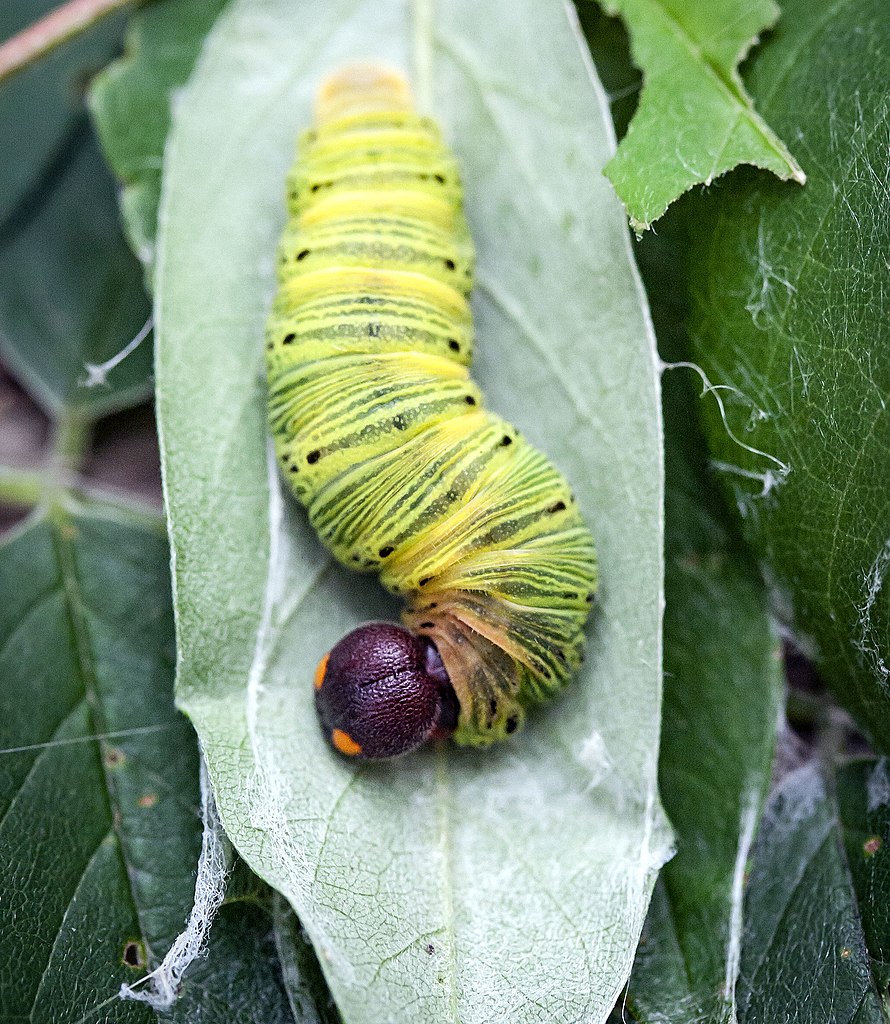
Trees, herbs, and various vines are the hoses of the Silver-spotted Skipper Caterpillar (Epargyreus clarus).
Pea family plants, black locusts, and wisterias are its common hosts.
The caterpillar has
a distinct yellow color and a robust wider body compared to other species.
Its head is dark brown while its eyes and prolegs are orange.
This species can also be seen as a low-threat pest on various crops such as those soybean and kidney beans.
4. Red-spotted Admiral Caterpillar

Black cherry and willows are the most common hosts of the Red-spotted Admiral Caterpillar (Limenitis arthemis).
This species is known for first being green, later changing into a multicolored species that mimic bird droppings.
Red-spotted Admiral Caterpillars show white and brown sections across their body.
The species is smaller than other common caterpillars such as The Eastern Tiger Swallowtail Caterpillars.
It grows up to a maximum size of 1.6 inches.
The species becomes comparable to others in terms of size once adult butterflies emerge.
Red-spotted Admiral Butterflies grow to a wingspan of up to 3.5 inches.
5. North American Luna Moth Caterpillar

Green is the color that marks the North American Luna Moth (Actias luna) the most, regardless of its life stage.
The caterpillars and the moths are green.
This species begins life as a green caterpillar. It grows to a species with small black spots to eventually become a green and red-orange caterpillar.
It transforms into a brown pupa to emerge as a green moth.
Various types of hardwood trees are hosts for the North American Luna Moth Caterpillar.
It prefers broadleaf trees as these provide the most nutrition for the species.
6. Common Buckeye Caterpillar
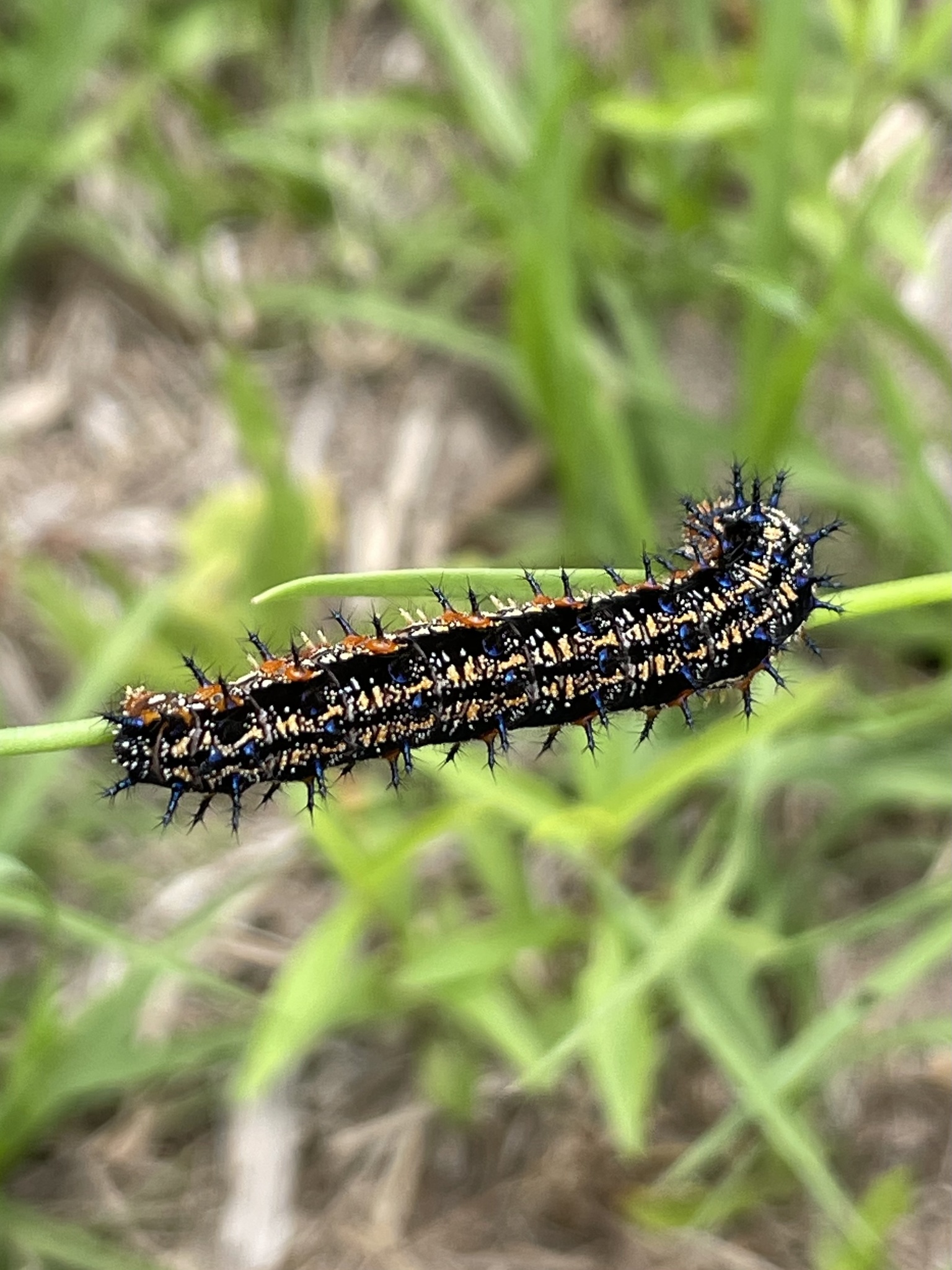
Some of the caterpillars with the most spines seen in North Carolina are The Common Buckeye Caterpillars (Junonia coenia).
This species comes with a black base color that features white or brown stripes.
Black spines cover its body to make it less approachable to predators.
This species emerges into a mostly brown butterfly.
Many types of short broad-leaf plants can be their hosts. Plantain remains the most desired host as it provides the highest nutritional benefits for the caterpillar.
7. Pipevine Swallowtail Caterpillar

Wild ginger, knotweed, and morning glories are among the plants and flowers this caterpillar (Battus philenor) can be seen around the state.
This is a species characterized by short or long tubercles, depending on its development stage.
It grows to a brown to-red color with long tubercles and red spots on its dorsal side.
A common sight across the state and in many other Eastern states, the Pipevine Swallowtail Caterpillar is mostly associated with pipevines and ornamental plants.
This species is known to mimic other potentially-dangerous specie such as Spicebush Swallowtails.
8. Pearl Crescent Caterpillar

Pearl Crescent Caterpillars (Phyciodes tharos) are a widespread species with a spike-covered body.
This species has dark brown coloring. It grows to a dark brown caterpillar with tiny white spots and rows of spikes.
While not poisonous, the caterpillar doesn’t appear palatable to some of its predators.
This caterpillar can be found across various dry habitats at different altitudes.
A rare sight on crops or in orchards, the species is seen on dry open lands.
They prefer asters as hosts.
Much of the dark coloring of the caterpillar is further visible on the contrasting adult butterfly of the species.
9. Black Swallowtail Caterpillar

Multiple types of native and introduced species of wild carrots are the hosts of the Black Swallowtail Caterpillar (Papilio polyxenes).
This is a species known for living on mock bishopweed and poison hemlock among other types of herbs.
The Black Swallowtail Caterpillar is only black in its initial growth stages.
It shows white coloring alongside its base black color later to eventually become a green caterpillar with black bands and yellow dots in its grown stage.
The damages this caterpillar causes range from minimum to complete defoliation, including host flowers and leaves.
10. Eastern Tent Caterpillar

This species (Malacosoma americana) is named after the communal silk tents it builds on branches.
Young caterpillars work together to create this tent-like protective structure.
Eastern Tent Caterpillars live social lives at first. As many as 300 eggs can hatch at a time which means a high number of caterpillars may live on the same host.
This species has a mostly dark body with just a few contrasting characteristics.
A dorsal stripe and a few colored spots contrast its body.
This species has a white dorsal stripe and blue dots along it.
Caterpillars of this species are identified by their tent-like structure with a Southeastern orientation on host trees.
11. Banded Tussock Moth Caterpillar

Late spring marks the appearance of the first Banded Tussock Moth Caterpillars (Halysidota tessellaris).
The species is active until late fall.
Distinct yellow hairs covering the entire surface of its body are what make this type of caterpillar easy to identify.
While not venomous, the long yellow hairs on the caterpillar may trigger skin reactions, especially for people with known allergies.
Redness and rashes are skin reactions commonly described by those handling Banded Tussock Moth Caterpillars.
12. Polyphemus Moth Caterpillar

This species of caterpillar (Antheraea polyphemus) undergoes considerable coloring changes as it grows.
It may even be confused with other species such as Monarch Caterpillars at first.
A white body with black bands and yellow sections is specific to this caterpillar at first, together with a brown head.
Polyphemus Moth Caterpillars eventually become green when fully grown. Tiny brown spots are seen across its body.
A common species across North Carolina, Polyphemus Moth Caterpillars aren’t pests in the state.
They are only seen as pests in California where they eat the leaves of cultivated plum trees.
13. American Lady Caterpillar

Everlasting herbs and various asters are the most common hosts of the American Lady Caterpillar (Vanessa virginiensis).
This native species is known for its dark or black body with black spikes.
The color of contrasting dots and stripes varies through its growth stages, but the black color remains constant.
Tiny red dots and yellow bands are characteristic of this caterpillar.
Its pupation stage is marked by uniform green coloring.
This species has a widespread distribution in the state and outside of the state, from North to South America.
14. Imperial Moth Caterpillar

Imperial Moths (Eacles imperialis) are characterized by yellow and brown colors which make them look similar to falling leaves.
The caterpillars of the species are initially orange and black, slowly turning to red-brown.
Various species of broad-leaf trees are the preferred hosts of the Imperial Moth Caterpillar.
Box elder, sweet gum, and various types of oaks are common hosts of the species.
To a lesser extent, the caterpillar might also be seen on decorative trees such as the eucalyptus.
You can remove the eggs of the species to avoid defoliation. Imperial Moth eggs are either yellow or green-brown.
15. Spicebush Swallowtail Caterpillar

Spicebush Swallowtail Caterpillars (Papilio troilus) use mimicry to avoid common predators and tachinid flies considerably reducing the numbers of the species.
This is a green caterpillar with a brown underside and large eyespots on its head.
It resembles a small snake and its vivid camouflaging colors help it survive some situations.
Apart from using mimicry techniques, Spicebush Swallowtail Caterpillars are also impersonated by other species.
Some types of green frogs with brown ventral coloring are believed to mimic these caterpillars.
16. Tulip-tree Beauty Caterpillar

As the name of the species implies, this caterpillar (Epimecis hortaria) lives and feeds on tulip trees.
It has an atypical appearance with a green-gray body that features yellow bands and yellow lines similar to veins.
Its prolegs are also yellow.
Commonly seen living on its own, this caterpillar species feeds on the entire leaves of its host.
In the absence of tulip trees, the caterpillar migrates to other trees with large leaves.
It moves towards magnolia or poplar.
To a lesser extent, it can also be seen in sassafras, a genus of host plants with carcinogenic oils.
17. Gulf Fritillary Caterpillar
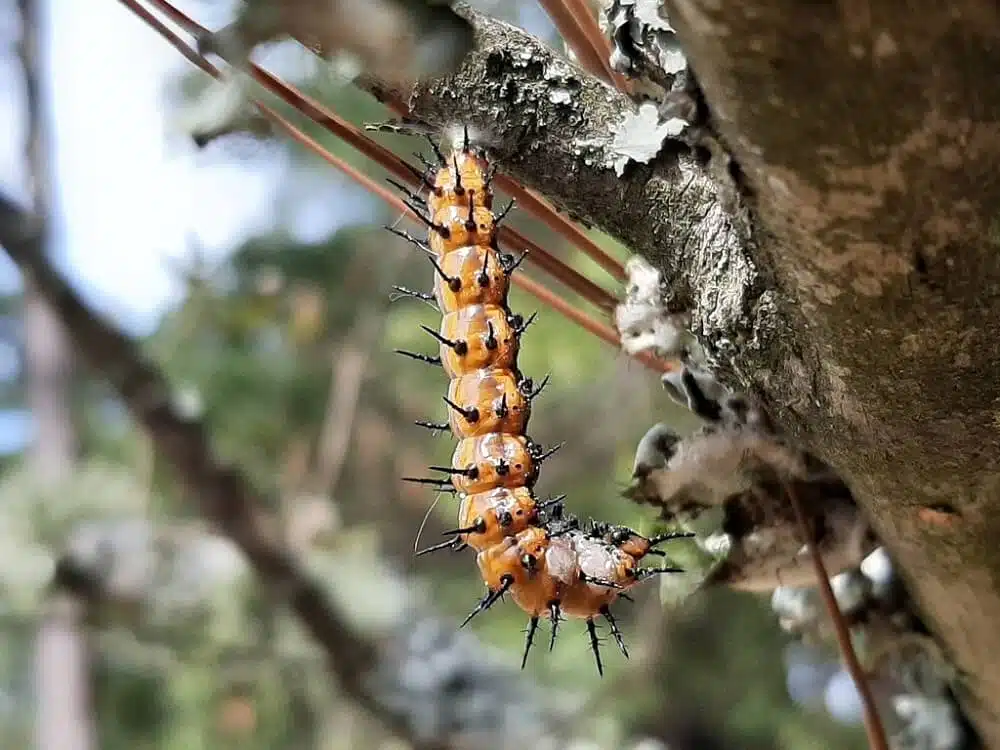
Passion vines are among the most common hosts of the Gulf Fritillary Caterpillar (Dione vanilla).
This species doesn’t kill passion vines as they only consume the edges or a small part of their leaves.
Gulf Fritillary Caterpillars are among the multiple North Carolina species fully covered in long black spikes.
While they may look threatening at first, they aren’t poisonous, venomous, or known to cause allergic reactions.
The species has an orange-brown color with black spikes throughout its growth stages.
Fine black stripes are further distinguishable on its dorsal side.
18. Rosy Maple Moth Caterpillar

Color changes are specific to the Rosy Maple Moth Caterpillar (Dryocampa rubicunda).
Feeding on maple trees, these caterpillars change colors 3 times before pupation.
Unlike the pink adult, this caterpillar is yellow-green at first.
It goes through 5 instars altogether. The caterpillar changes coloring to green in its growth stages to finally become red in the final instar.
You can only spot Rosy Maple Moth Caterpillars feeding on maple trees in groups from the first to the third instar as they become solitary afterward.
19. Ailanthus Webworm
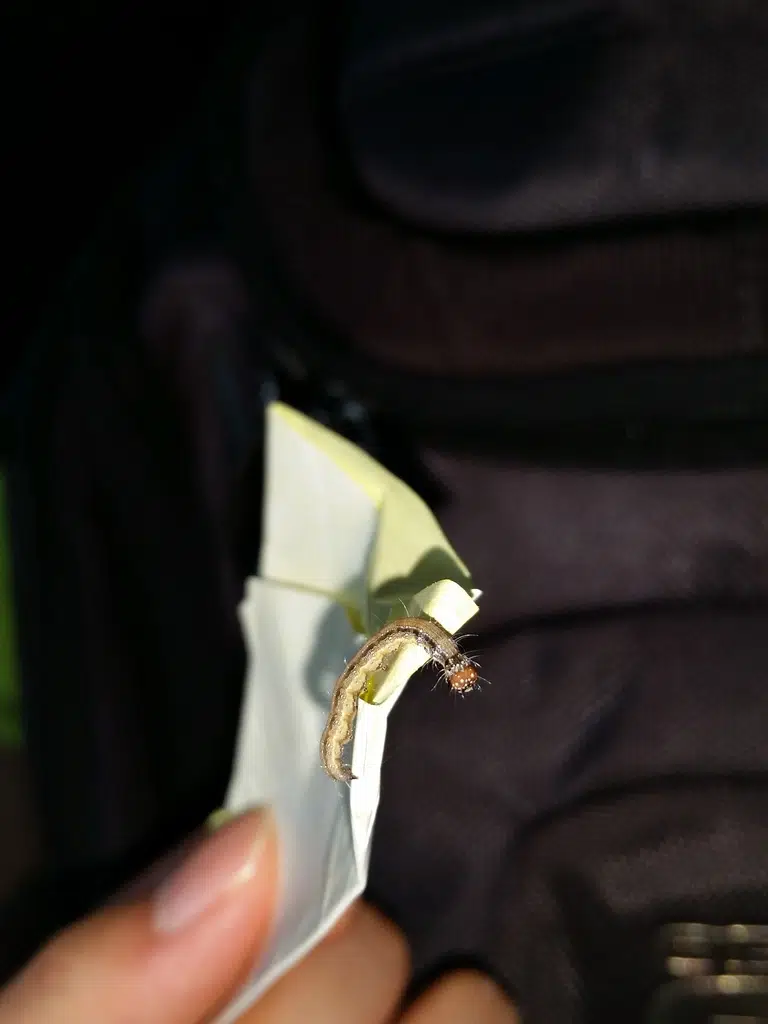
Ailanthus Webworms (Atteva aurea) are found on Paradise Trees and invasive Trees of Heaven.
These caterpillars build nests out of the leaves of these trees. Up to 3 leaves are tied in a web.
These leaves and bark are consumed and used as shelter and as food.
Different brown colors with a striped appearance characterize these caterpillars which may also be black at a given growth time.
Multiple generations of the caterpillar can be seen each year.
20. Giant Woolly Bear

Giant Wooly Bears (Hypercompe scribonia) have long black setae that are sometimes confused with spikes.
Black stiff setae cover the body of Giant Wooly Bears. The species uses these stiff setae to defend itself.
The caterpillar curls up into a ball so that predators and even humans can’t harm it.
Giant Wooly Bear Caterpillars feed on legumes and flowers but aren’t major pests and no specific action needs to be taken against them.
They can be spotted on lemon, cabbage, plantain, and willow.
Sunflower fields also attract the species, but in very low numbers for economic losses.
21. Variegated Fritillary Caterpillar

Climbing milkweed and passionflowers are among the typical hosts of the Variegated Fritillary Caterpillar (Euptoieta claudia).
The species is marked by brown, white, and black longitudinal stripes. It also has scarce black setae.
Up to 3 broods of Variegated Fritillary Caterpillars are seen each year.
This species butterfly of the species is known to migrate Southwards for overwintering.
Variegated Fritillary Caterpillars eventually become white in the chrysalis stage to turn back to brown and black in the butterfly stage.
22. Banded Woolly Bear

Banded Wooly Bears (Pyrrharctia isabella) are some of the most common species in North Carolina.
This is a species that lives in all habitats where there’s plenty of vegetation to feed on.
As a generalist feeder, the Banded Woolly Bear Caterpillar feeds on all types of flowers, herbs, shrubs, and trees.
It has a body covered in spiny brown and black hair.
These hairs are sharp and may cause small skin-level reactions but they aren’t poisonous and they don’t cause lasting urticaria as with other types of caterpillars.
North Carolina is home to the Woolly Worm festival held in the Western town of Banner Elk.
23. Cloudless Sulphur Caterpillar

Cloudless Sulphur Caterpillars (Phoebis sennae) have established populations across the state. Properly documented by the University of North Carolina, this is a species that has vivid green or yellow coloring.
The colors of the Cloudless Sulphur Caterpillar resemble those of a sensitive pea, one of its preferred hosts.
This caterpillar begins life as a yellow species.
It then turns green with yellow only being visible on lateral bands along its body.
Cloudless Sulphur Caterpillars are yellow in their final growth stages. The pupa of the species can also be green, yellow-green, or pink and yellow.
24. Fall Webworm

Fall Webworm larva (Hyphantria cunea) are among the species easy to spot on host trees with their silky webs on host plants.
They combine multiple leaves in a cocoon-like silk tent.
The hairs of Fall Webworm caterpillars are irritating and handling the species by hand isn’t recommended.
Releasing irritating chemicals is also specific to this species which shows multiple defensive methods.
Willows are among the common trees of the state mostly impacted by the species. They are always characterized by a fuzzy silk web.
25. White-marked Tussock Moth Caterpillar

White-marked Tussock Moth Caterpillars (Orgyia leucostigma) have a hairy body with 4 large defensive glands.
The species has black and red coloring with scarce white hairs and long tufts on the head.
Young caterpillars eat the surface-level leaves of multiple trees such as willows. Grown caterpillars eat entire leaves except for the veins.
Complete defoliation and outbreaks are rare in the species. Most of its damages are seen North of North Carolina with the Manitoba maple.
No specific management measures are needed for the species as most get eaten by birds.
26. Snowberry Clearwing Caterpillar

Dogbane and honeysuckle across the state are some of the typical host plants of the Snowberry Clearwing Caterpillar (Hemaris diffinis).
Snowberry and mint are among the other species of plants this caterpillar is interested in.
The Snowberry Clearwing Caterpillar has a very similar appearance to other green caterpillars.
It has a base light green color with black horns. The base of its horns is yellow.
A yellow lateral stripe is seen along the sides of its body. Tiny black dots are also present in the species.
27. Clouded Skipper Caterpillar
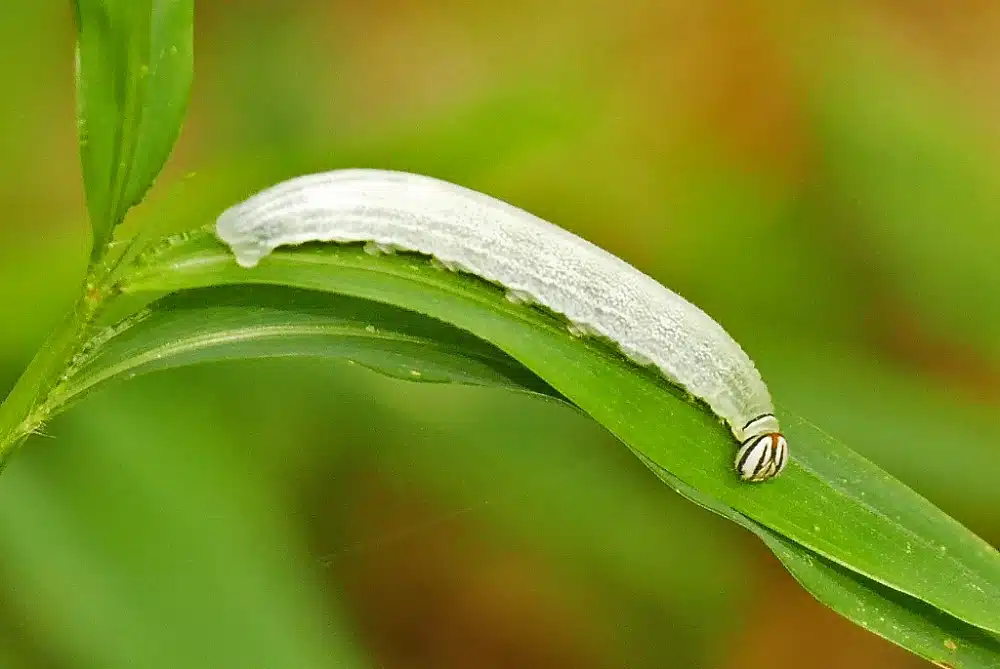
Clouded Skippers (Lerema accius) are some of the most common skipper butterflies in the state. Their caterpillars are a common sight through their host plant.
Various types of grass such as St. Augustine Grass are the hosts of this species.
These caterpillars have a green color with dark green dorsal stripes which are only visible as the caterpillar reaches its final growth stages.
The butterflies of this species don’t feed on grasses as they prefer the nectar of various colorful asters.
28. Great Spangled Fritillary Caterpillar
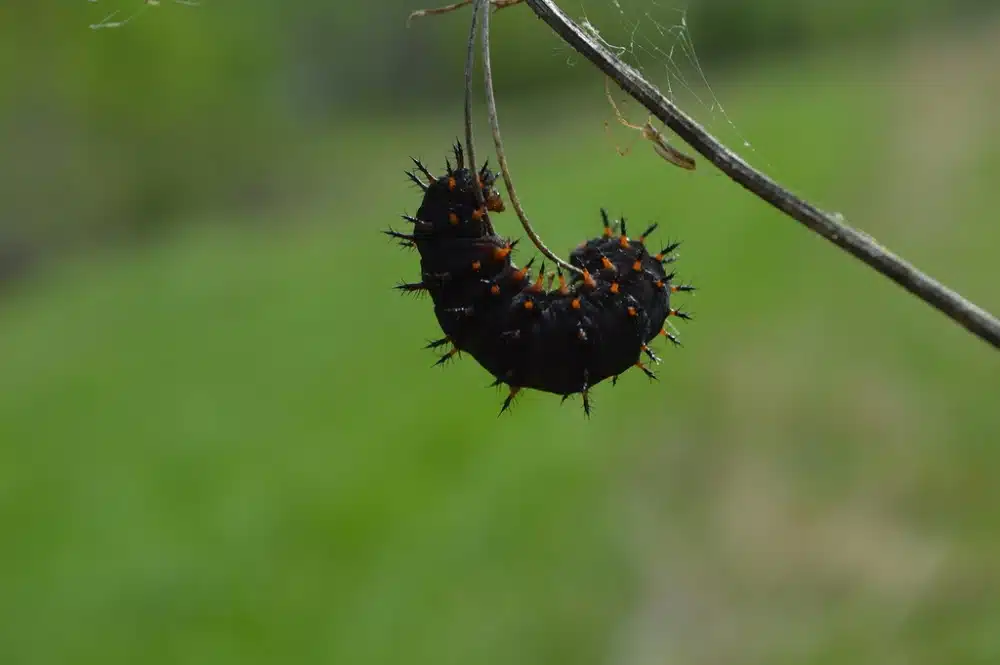
The Great Spangled Fritillary Caterpillar (Speyeria cybele) is known for its black color with brown spots.
North Carolina represents the Eastern limits of its range, a species that’s common through many US states.
The Great Spangled Fritillary Caterpillar is a species that only feeds on violets.
It uses different types of violets as its hosts, with reduced interest for other plant hosts.
The colors of the caterpillar are inverse to the adult butterfly which is mostly brown and partly black.
29. American Dagger Caterpillar

One of the most distinct species in the state is the American Dagger Caterpillar (Acronicta americana).
It has a yellow and black body at first, growing long yellow hairs as it grows.
The species can cause mild skin reactions such as rashes when handled.
Woodlands are the only habitat where this species is seen in the state.
It prefers deciduous broadleaf trees as food. Hazel, hickory, and walnut are among the most common hosts of the caterpillar.
30. Small White Caterpillar

One of the most important pests on North Carolina crops is the Small White Caterpillar (Pieris rapae).
A pest of crucifer crops, the Small White Caterpillar is a species that needs to be managed.
Cabbages tend to be the most impacted by the caterpillar. Its feeding habits may also affect other crops such as those kale, broccoli, and horseradish.
The species is rarely visible as it lives inside cabbages and kale.
When spotted, its green color is what makes it stand out. Small yellow dots and stripes are further visible on the species.
31. Orange Caterpillar

Sleepy Orange Butterflies (Abaeis nicippe) are among the most common species of butterflies in North Carolina.
They stand out with their vivid orange coloring or yellow-orange coloring that dominates their wings.
The caterpillars of the species are mostly green. They live on pea family plants.
Sleepy Orange butterflies are found nearby, feeding on plant nectar.
Butterflies of the species don’t feed on pea family nectar as they prefer the nectar of other plants such as shepherd’s needle.
32. Question Mark Caterpillar
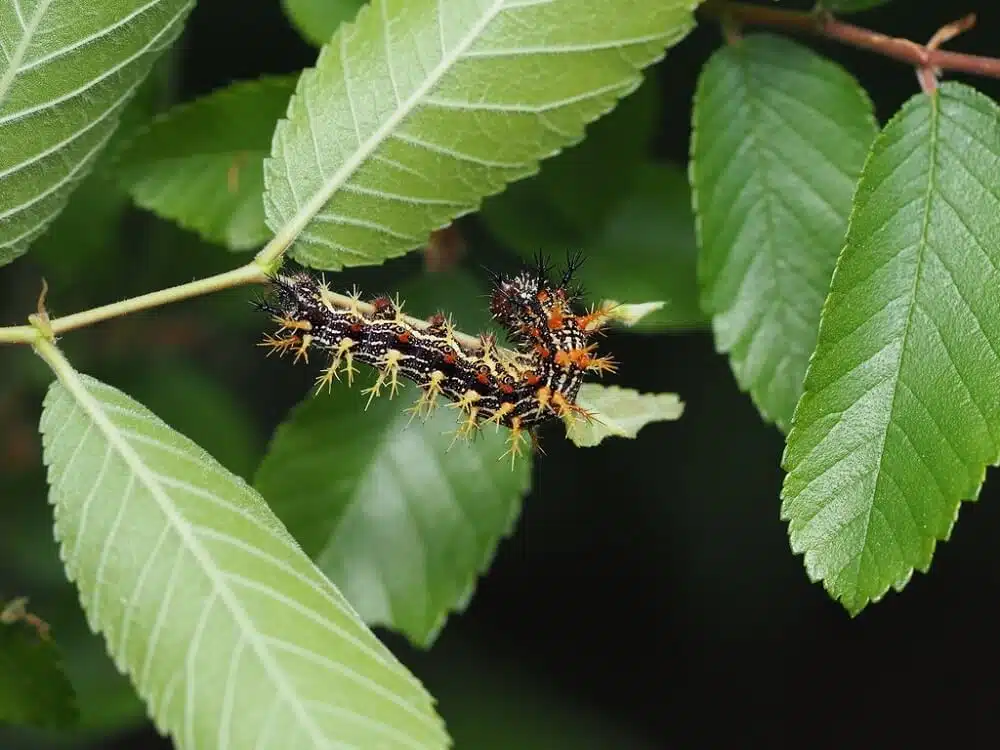
Various nuances of orange and black coloring mark the identity of the Question Mark Caterpillar (Polygonia interrogationis).
This is a species known for its impact on American Elm. While limited, outbreaks might still lead to partial tree defoliation.
Identifying the caterpillar for quick management techniques is not complicated.
The species has orange, brown-orange, or red-orange coloring on a dominant black body.
It can be found on tree leaves of local elm trees but it may also be seen on false nettle.
33. Carolina Sphinx Caterpillar

Economic impact is tied to the crops affected by the Carolina Sphinx Caterpillar (Manduca sexta). This is a species known for its potato and tomato hosts.
It can be found both on crops and in gardens across the state.
Carolina Sphinx Caterpillars are also known to impact tobacco fields while the adult moth of the species is known to feed on honeysuckle.
The green color with white diagonal bands is specific to this caterpillar species.
34. Red Admiral Caterpillar

Red Admirals (Vanessa atalanta) are among the most common migratory butterflies seen across North Carolina. Both weather and food availability make the species a common sight here.
The caterpillars of the species bear some coloring resemblance to these butterflies.
They are mostly black, similar to the black color dominating the wings of the butterfly.
Black spines also cover the body of the caterpillar throughout its growth stages.
Stinging nettle is one of its hosts and one of the main reasons for Red Admiral migration.
35. Yellow Woolly Bear

This species of woolly bear caterpillar (Spilosoma virginica) has a light yellow color and a hairy body.
Yellow Woolly Bear caterpillars feed on various plants, including clover. Their damages might not be significant most months, but can be impactful at the end of the summer.
Spotted in multiple broods per year, this is a species known to only be problematic at the end of the summer.
A small number of people coming in contact with the Yellow Woolly Bear Caterpillar may show allergic skin reactions.
Once an adult, it turns into a white moth
36. Tulip-tree Silkmoth Caterpillar

Tulip trees and magnolias are the most common hosts of the Tulip-tree Silkmoth Caterpillar (Callosamia angulifera).
The species can come with a considerable impact on its host given it feeds constantly until pupation.
It stops feeding once it turns into an adult Tulip-tree Silkmoth.
2 broods are specific to the species in North Carolina.
The first brood appears up until April while the second brood makes its appearance at the end of the summer in August.
37. Gray Hairstreak Caterpillar

Gray Hairstreak Caterpillars (Strymon melinus) are present in almost all states, including North Carolina.
The species has a typical green color, specific to most caterpillars in the state.
It feeds on many types of host plants including mallows and other types of pea plants.
The complete list of Gray Hairstreak Caterpillars is longer year on year since the species is seen eating tens of species of plants.
Legumes are also consumed by this species. The economic impact of the caterpillars is reduced compared to other pest caterpillars.
Adults also feed but prefer milkweed and other herbs.
38. Yellow-striped Armyworm
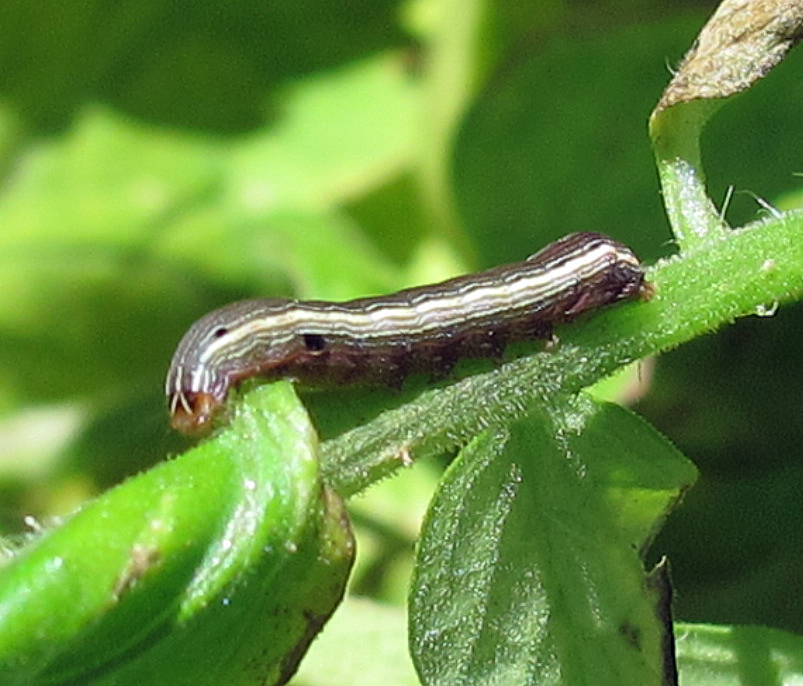
Unlike the Gray Hairstreak Caterpillar, the Yellow-striped Armyworm Caterpillar (Spodoptera ornithogalli) is seen as a major pest on North Carolina crops and in greenhouses.
It’s here that the species feeds on corn, beet, cabbage, lettuce, potatoes, peas, and different types of melons.
Even other types of crops such as soy and cotton may be impacted by this species.
Management techniques including chemical use and encouraging parasitoid wasps in the area are often necessary.
This species has a mostly dark brown body with yellow, black, and white dorsal stripes.
Its prolegs tend to have a brighter brown color compared to the dark brown color of its body.
39. Forest Tent Caterpillar

Forest Tent Caterpillars (Malacosoma disstria) are also damaging to the ecosystem, even if not to crops such as The Yellow Striped Armyworm.
Forest Tent Caterpillars impact trees. They feed and affect oak, aspen, and sugar maple, among other tree species.
Most times, the damages caused by hungry-feeding Forest Tent Caterpillars are manageable for trees that easily regenerate lost leaves.
Outbreaks are the ones to worry about when it comes to Forest Tent Caterpillars.
An outbreak of this species can last up to 3 years and it occurs at least once per decade.
40. Palamedes Swallowtail Caterpillar
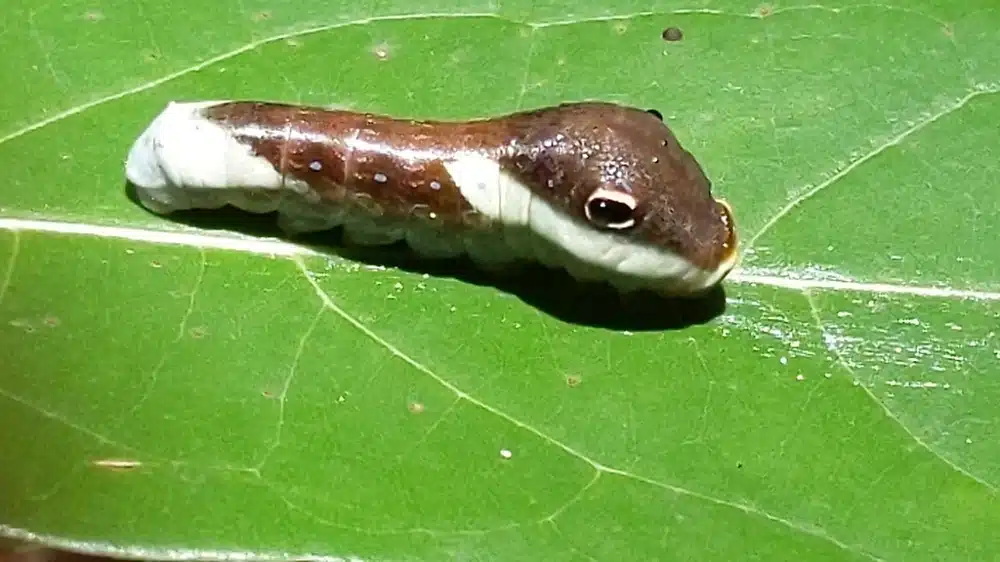
Red bay is one of the most impacted species when it comes to the Palamedes Swallowtail Caterpillar (Papilio palamedes).
Most damages to this species are noted in Florida but they can also apply to other related species found in North Carolina.
The late instar caterpillar causes curled leaves on these hosts and may eventually kill the host in the absence of a true predator.
One of the reasons this caterpillar still manages to kill red bays is due to its camouflaging colors and habits.
The early growth caterpillar stage is when the species hides in curled leaves. Large eyespots on its head also keep many predators away.
41. Hackberry Emperor Caterpillar

Hackberry Emperor Caterpillars (Asterocampa celtis) start life as pearl-white eggs.
They grow into large green caterpillars with brown and black horns.
Sugarberry or hackberry trees are the most impacted host species of this caterpillar.
Damages can be extensive but many caterpillars perish as prey for different types of Ichneumonid wasps.
One of the methods used to determine the impact of Hackberry Emperor Caterpillars is by assessing warts on tree bark.
Complete defoliation is possible, but still a rare sight.
42. Long-tailed Skipper Caterpillar

This caterpillar species (Urbanus proteus) are among the few green species of North Carolina with additional yellow coloring and orange coloring.
Its green body has a base green color with a dark green dorsal stripe, a brown head, and orange marks on the head and the anal plate.
This species is specific to different types of vines across the state.
Once an adult, this skipper is mostly blue, black, and gray.
43. Hummingbird Clearwing Caterpillar
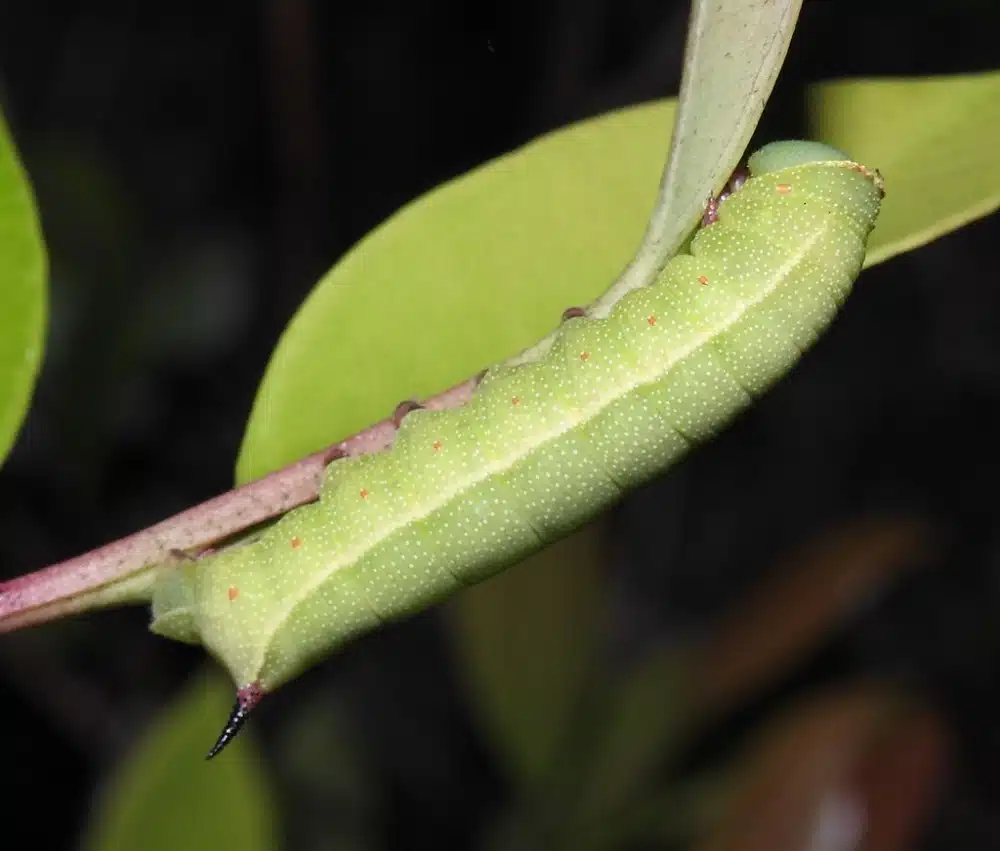
A common species even in suburbs, the Hummingbird Clearwing Caterpillar (Hemaris thysbe) is a species that feeds on honeysuckle and snowberry.
Both the caterpillar and the Hummingbird Clearwing Moth feed on honeysuckle.
There are 2 broods per year in the state.
The first broad appears up until June with the second brood coming later in September or October.
44. White-dotted Prominent Caterpillar

Oak trees are the main host of the White-dotted Prominent Caterpillars (Nadata gibbosa).
As with other species feeding on oak, secondary hosts are also palatable. These include plums and roses.
The species has a bright green color that almost appears white. Side white stripes and tiny red dots are seen across its body.
The White-dotted Prominent Caterpillar gets its name from the tiny white dots scattered on its body.
The period between April and October is the time when this species is most active.
45. Silvery Checkerspot Caterpillar

White dots are also seen in high numbers on the Silvery Checkerspot Caterpillar (Chlosyne nycteis).
This species is brown and black. It has black spines and tiny contrasting white dots on its body.
Its numerous status across many dry habitats are of low economic importance.
This species only feeds on asters. Different types of asters are preferred by the species starting with yellow ironweed.
46. Viceroy Caterpillar

Viceroy Caterpillars (Limenitis archippus) are mostly found next to the water in areas with willows.
Feeding on willow leaves, Viceroy Caterpillars have few natural predators due to their camouflaging colors.
The species mimic bird droppings with red, pink, black, and white colors.
Adults of the species are just atypical as caterpillars. Viceroy Butterflies are commonly seen feeding on feces.
Viceroy butterflies are also unpalatable to predators through the toxins consumed by their caterpillars.
Up to 3 Viceroy Caterpillar broods per year are seen in North Carolina. The eggs of the species may be confused with galls.
47. Common Eupithecia Moth Caterpillar
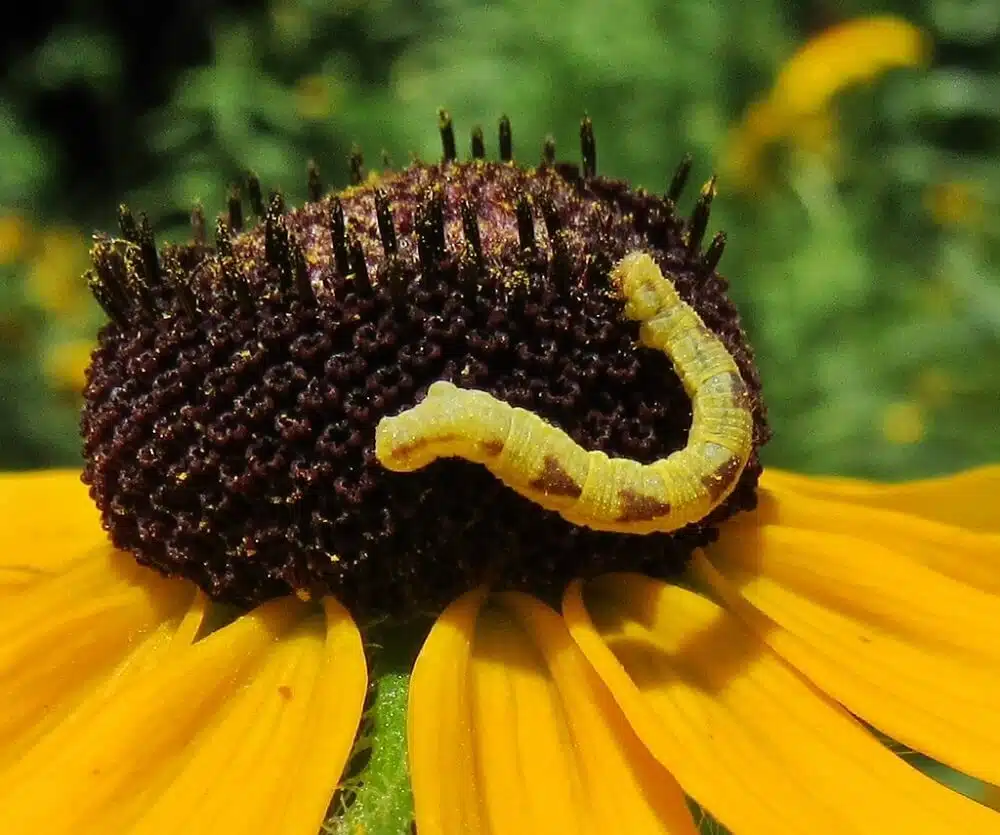
Green main color with large brown dorsal spots is specific to The Common Eupithecia Moth Caterpillar (Eupithecia miserulata).
This is a species that can have a detrimental effect on wildflowers and some trees.
It feeds on asters, cherries, and willow tree leaves.
The main defense of the species is to camouflage itself on leaves. This is why the brown spots on its body are variable, depending on the color of its host.
You can sometimes find this caterpillar on willows across the state, up to November.
48. Yellow-striped Oakworm
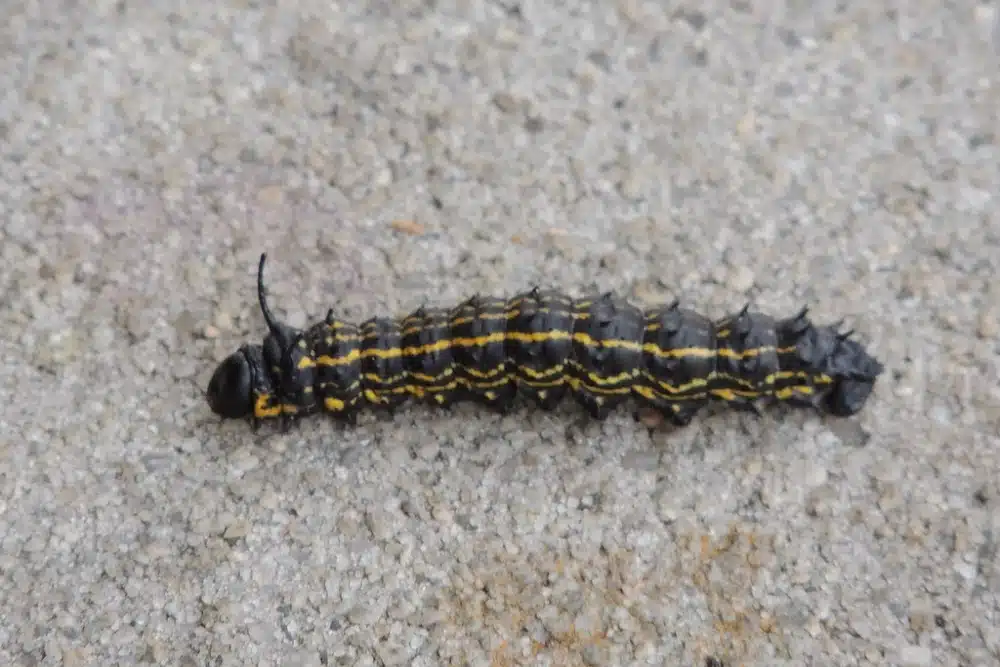
Various types of oak such as Southern red oak are the hosts of the Yellow-striped Oakworm (Anisota peigleri).
This is a black caterpillar showing contrasting yellow dorsal stripes.
Its impact on local oak trees is still minor, but there’s always a risk of an outbreak and defoliation as in Florida.
The species needs to be managed early. Removing the eggs of the species from the leaves is a common management technique.
Its eggs are yellow and found both on the upper and the lower side of the leaves.
Maintaining proper tree health, pruning, and watering are good preventive measures against the species.
Unhealthy laurel oaks tend to be the most exposed species to Yellow-striped Oakworm defoliation.